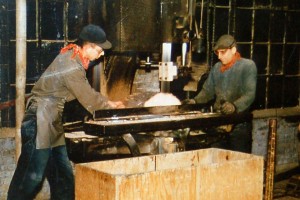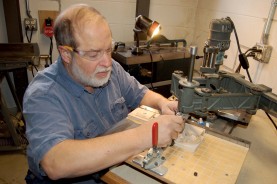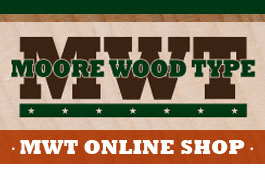Maple Logs to Wood Type, A Modern Version (2)
One of the best things about cutting wood type, using the historical process, is that every step, from maple tree to printing press, has been done sometime in the past. One of the worst things about cutting wood type is that very little information is available about the technical details of the process. There is a little information in the Rob Roy Kelly book, but all the other references to preparing the maple slabs for cutting type seem to be copied from the same source.
My two trips to the Hamilton Wood Type & Printing Museum in Two Rivers, Wisconsin have been the best source of information. The displays in the museum, with their factual information panels, and the actual machines that they allowed me to measure and take photos of have been the most help. Discussions with Jim Moran, Norb Brylski, and type experts like David Shields and Celene Aubry have answered most of the questions.

Cutting frozen half slabs at Two Rivers, Wisconsin in 1958 (Photo courtesy of Hamilton Wood Type Museum)
Thirty-five years as an Industrial Arts teacher, working with wood and woodworking machines has been a big help. I have sticked and air dried hardwood rough cut boards myself, and have studied the kiln drying process as part of my Masters Degree from Miami University. However, air drying one and quarter inch thick end grain half-slabs of frozen hard maple to be cut into wood type is something no one has done for about 50 years.
I decided to start the “Great Maple Log Adventure” this past Winter so I would have lots of dry, hard maple in stock for next Winter. One of my favorite quotes is from Helen Keller, “Life is either a grand adventure or nothing.” And I knew I needed lots of hard maple.
I used the internet and phone to start looking for a lumber yard in Ohio that would sell me four, hard maple logs, between 14 to 16 inches wide, frozen solid, with the “sap down,” and ripped in half length wise. This is the type of starting logs all the reference books, and exhibits said I needed.
Most of the Sawyers I contacted thought I was crazy. They had never heard of anyone wanting half slabs of end grain hard maple crosscut to one and one quarter inches thick. The additional conditions that they needed to be cut and kept frozen in February, before the sap in the maple trees started running, and that I wanted to keep the bark on the logs to help control the drying process was a big obstacle. The sawmills all wanted to debark the logs to protect their saw blades.
I found several lumber yards in Amish country willing to provide the wood I wanted at a reasonable price. The downside was that the total weight of the 8 half logs would be around 2,000 pounds “green”, and I would need to transport them myself the two hour road trip back to Central Ohio.
I was ready to rent a truck and commit to the trip when I had one of my lucky contacts. I was discussing my problem with several woodworkers when a friend mentioned he had a business contact only four miles from my school woodshop that had a bandsaw sawmill on his farm. He also had a large, family owned woodlot with 45 year old hard maple trees. Randy Smith, owner of Timbertree Farm in Baltimore, Ohio would solve all my problems. (continued)



